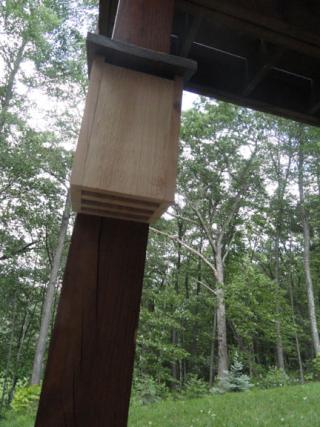Attracting Bats and Setting Up Bat Houses

There are typically two types of bats found in this area: little brown bats and big brown bats. Bats help control insects (they can eat up to 500 per hour throughout the night!), pollinate plants, and scatter seeds. One reason the bat population is declining is due to loss of habitat and providing a bat house will help bats survive.
Location is very important to bats. Northern bats crave warmth, so their houses should be placed in a location where they get at least four hours of sun each day. Nursery colonies (groups of mothers with young) are particularly temperature sensitive. Big brown bats prefer roosts that remain at 80º to 90º for most of the day and night and little brown bats like their homes even warmer. East, southeast and south facing locations are the most popular. It may help to use a dark (black or brown) color water-based paint or stain on your bat house.
Bat houses should be at least 12 feet high; 15-20 feet is even better. The house should be mounted on a building or pole; bat houses placed on trees are seldom used. It is ideal to place bat houses on a pole, back to back, at least 25 feet away from lights. Also, try to place the house away from tree branches which may make aerial perches for predators. Tilting the nursery houses (small size) about 10º will help keep baby bats from falling out.
Houses placed in locations within ¼ mile of a stream, river, or large lake are most likely to attract bats due to the high concentration of insects. This type of location is especially popular for nursery colonies.
Take care when placing your bat house. Bat houses have open bottoms and guano will pile up underneath. Also, bat urine can stain some finishes.
Attractants do NOT attract bats to a bat house. Bats explore for roosting sites during the night. If your house does not attract bats after the first season, it is probably due to the location. Try moving the bat house to a different spot.
Maintain your bat house by cleaning it out each winter, especially if wasps or mud daubers move in during the summer. Repaint if necessary. Bats don’t like drafts, so if the roof or sides develop gaps over time, seal the gaps with caulk.

